PCV Valve installation
Comments
-
This is an excerpt from a form of communication (Williams' archives) I received in 2004 concerning PCV; BELIEVE IT OR NOT!
".. As for your idea of PCV, now you are getting into the realm of actual engineering problems, and I'm glad you asked before you did anything. If you really want to contaminate the inside of an engine, put PCV on it. Perhaps you didn't realize that a Hudson, and all flathead engines, were never supplied with valve guide seals. Nor do they need them if there is no source of engine vacuum metered through a calibrated orifice (PCV valve) trying to pull oil through the guides. An engine not designed for PCV will burn oil and foul plugs with PCV. And it will carbon up excessively. No problems can occur......., but serious problems up to and including engine failure can result from re-engineering the engine's crankcase ventilation systems without sufficient background in doing so."
I removed some irrelevant portions, but I suspect you see how ENLIGHTENING things can become when you ask just anyone a question.
As far as the location that you provided; PERFECT, rational location! I plan to install PCV on mine in the very near future. I Bought a circle track valve cover type filter from K&N that slips snugly over the oil filler tube, which will keep the air clean that'll enter the crankcase (the original type filters are inefficient and will not adequately filter the air).
Best to you!0 -
Dave, how did you wind up doing the PCV valve? Anyone else chime in!0
-
I didn't.0
-
FYI
I have PCV Valves on all my Hudsons stock & m,odified over a Decade with no problems. Admittedly, I only drive them in the mild weather Months, but think a problemn would have surfaced by now....
To install, I put a grommet into the Draft Tube, or hole in valve cover, then used a GM PCV Valve and ran a hose to a vacume source. (I used an Intake Fitting) Then, I installed a Mopar 'Fill Cap' with a Nipple to run a hose to an Air Filter.
Ive cut a hole in a Filter Cannister, but now I put 'universal nipple' or Hose wire tyed onto the air filter element. Either way completes the 'cycle'. (I didnt want to drill a Twin H Filter)
(A PCV Valve really helps a worn engine 'breathing' at a traffic lite)0 -
Ol Racer,
I was doing some google searches on this since i will be adding a PCV in place of the draft tube.
I've been searching for a grommet to fit the 1 3/8" hole in the lifter cover.
The ones I have found are only 1 3/8 OD so I would need to tig in some sheet metal and drill the 1" hole.
Do you have a part number for the grommet you used?
Did it require any modification?
I would like to find something that is a drop in so other can do it with out needing to modify the original part.
Also,
have you tried differnt PCV valves?
The flow is different on 4, 6, and 8s.
A couple thoughts on the post above...
Vavle guide seals do not seal or prevent oil from going on to the valve stem unless you machine the guide and install the late version PC-positive lock seals.
O-ring seals like used on a lot of GMs and IHs, and umbrella seals used on fords simply provide an oil run off lip so the oil doesn't run straight down the stem.
Flat head valves are inverted so no seal is used, I would assume mostly because there is no way for gravity to flow the oil up hill.
Next thought is, how is the engines vacuum going to overcome the pressure in the intake or exhaust runners to be able to draw oil into them?
Seems like crankcase vacuum would actually be drawing oil away from the stems, not causing it leak by more?
It is designed to preven crankcase pressure so the oil doesn't try to escape the crankcase any where it can, like seals, gaskets and even guides.
No matter what your opinion is...you can find some one on the internet to support your point of view!
Here is a tech artical from the old Hastings company on PCV valves.
--------------------------------------------------------------------------------
Positive Crankcase Ventilation is a system that was developed to remove harmful vapors from the engine and to prevent those vapors from being expelled into the atmosphere. The PCV system does this by using manifold vacuum to draw vapors from the crankcase into the intake manifold. Vapor is then carried with the fuel/air mixture into the combustion chambers where it is burned. The flow or circulation within the system is controlled by the PCV Valve. The PCV Valve is effective as both a crankcase ventilation system and as a pollution control device.
PCV systems have been standard equipment on all new cars since the early sixties. Prior to 1963 PCV was only used in California. There are a variety of PCV systems used on various makes and models of cars produced since 1963, but all function essentially the same.
PCV systems can be described as either open or closed. The two systems are quite similar. However, the closed system in use since 1968 is more effective at air pollution control. The systems differ in the manner in which fresh air enters the crankcase and excessive vapor is expelled.
Open PCV Systems
The open system draws fresh air though a vented oil filler cap. This presents no problem as long as the vapor volume is minimal. However, when the crankcase vapor becomes excessive it is forced back through the vented oil filler cap and into the open atmosphere. The open PCV system, though successful at removing contaminated vapors from the crankcase, is not completely effective as a pollution control device.
Closed PCV Systems
The closed PCV system draws fresh air from the air filter housing. The oil filler cap in this system is NOT vented. Consequently, excess vapor will be carried back to the air filter housing and from there into the intake manifold. The closed system prevents vapor, whether normal or excessive, from reaching the open atmosphere. The closed system is very effective as an air pollution control device.
The PCV Valve
The most critical part in the PCV system is the flow control valve, commonly referred to as the PCV valve. The purpose of the PCV valve is to meter the flow of the vapor from the crankcase to the intake manifold. This is necessary in order to provide proper ventilation for the crankcase, while not upsetting the fuel/air mixture for combustion.
Blow-by gases and vapor should be removed at about the same rate they enter the crankcase. Since blow-by is minimal at idle and increases during high speed operation, the PCV valve must control the flow of vapor accordingly. The PCV valve is designed to compensate for the engine ventilation needs at varying engine speeds. It is operated by manifold vacuum which increases or decreases as engine speeds change.
For example, at low or idle engine speeds manifold vacuum is high. This pulls the plunger to the extreme forward position, or manifold end of the valve. Due to the shape of the plunger, vapor flow is reduced to a minimum. The low rate of the flow is adequate for ventilation purposes and will not upset the fuel/air mixture ratio.
At high speeds manifold vacuum is decreased. The plunger is only drawn to a point about midway in the housing. This allows a maximum flow of vapor. Since the engine needs more fuel/air mixture at high speeds, the introduction of more vapor does not affect performance. In the event of a backfire, pressure from the intake manifold forces the plunger to the closed or engine-off position. This prevents the backfire flame from reaching the crankcase and exploding the combustible vapor.
A neglected PCV system will soon fail to function and the result can be expensive as well as troublesome for the car owner. If the crankcase is not adequately ventilated, the motor oil will quickly become contaminated and heavy sludge accumulations will begin to form. Internal parts, not protected by the motor oil, will begin to rust and/or corrode due to the water and acids that will become trapped within the crankcase. If the PCV system is not functioning properly, the flow of crankcase vapor into the intake manifold will not be properly metered. This, in turn, will upset the fuel/air mixture for combustion and cause rough idling or even stalling of the engine. Furthermore, intake and exhaust valves, in addition to spark plugs, may well be burned and rendered useless, prematurely affecting performance and requiring expensive repairs. To assure trouble-free performance of the PCV system and, in turn, the engine and vehicle, routine maintenance of the PCV system is absolutely recommended and required.
A PCV valve should never be cleaned and placed back into service. Cleaning a PCV valve will result in a clean PCV valve; not a new PCV valve. There are contaminants that will remain in the PCV valve that can never be flushed out. Additionally, there is an amount of wear that will be experienced by the spring that cleaning cannot replace. The recommended replacement intervals are a maximum of 12 months or 10,000 miles (16,000 km). Since vehicles and operating conditions vary, the valve may have to be serviced more frequently. If it is suspected that the valve is sticking or if there is evidence of sludge, the valve should be replaced.
All hoses or tubes used in the PCV system should be cleaned and inspected. If any cracks or breaks are noticed in the hose, it should also be replaced. All hose connections should be inspected to assure an air-tight seal.
Proper servicing of the PCV valve system will help reduce overall vehicle emissions.0 -
I've been using PCV systems on both our '47 (212) and Jet since rebuilding both of them and am glad I did so. I'm not shocked that some old timers say it's a bad thing but there are good reasons to do it. I installed 2 inch dia. observation ports on both pans to observe the degree of sludge accumulation over time. t's my personal belief that the nasty levels of sludge in our old engines has more to do with adequate crankcase ventilation than what kind of oil you use. Exclusion of dusty air from the CC is also a huge plus.
The level of pressure drop in the crankcase due to the PCV set-up is nearly immeasurable with ordinary gauges and certainly can't have any effect on oil consumption. Sounds like one of those deals where the PCV valve got blamed for smoke from somebody's worn out engine.
0 -
FYI
I installed a grommet like used on a Chevy big block V8 Valve cover's. I buy various size new grommets from Swap Meet Vendors that are not numbered. Ive sealed grommets to fit but never certain it will remain in place so found shortening the draft tube is better by inserting a Hose with 0-Ring and/or sealer into Tube then run hose out toward the intake manifold and install the PCV eases replacement if/when necessary. I use a PCV for a small Chevy V8. Actually Ive used any PCV I had in the cabinet.
The last PCV Valve I installed on a Hudson Owner's motor that had worn guides (blow by) but good Compression, the carb mixture screws needed re-adjusting afterward to idle smoothly and he's happy with the changes.
The System works well on both stock & modified motors. Ive never replaced a valve yet and have not noticed increased sludge when draining oil.
The PCV Article was very Interesting but I will remain with my set-up. Additionally, since I have only modern type Pressurized Oil Systems,(262 & 308) It was interesting to learn Frank Vintage Full Flow has had good PCV results with an older 212 Splasher Engine too.
0 -
I was slightly concerned with driveability issues and the possibility of leaning out of the mixture due to the introduction of air into the intake manifold but no such issues arose. Sludge would certainly not increase with addition of a PCV system......quite the opposite. Sludge reduction or elimination was the goal. To observe air/fuel ratio, I installed an O2 sensor and digital A/F ratio meter so that I could watch it on the fly. I was expecting a lean reading but was somewhat surprised to see it running at 12:1 most of the time. 12.5 was about the leanest I could get it. I was looking for 14 but only saw that upon deceleration. Being a "splasher" shouldn't have any bearing on PCV performance that I can imagine. Why would it care about the design of the lubrication system? In terms of valve guide lubrication, I doubt that there is any difference since the pressure lubed engines are basically splash lube as it pertains to the tappet chamber area anyway. Since the CC is basically open to atmosphere by way of the air inlet to it, there is no reason to think that the CC pressure would be significantly reduced.
In the case of the 212, there were a number of related modifications to the engine to seal up the CC so that air would not be allowed into it from any other pathway.....like the annular space around the non-existant rear main seal. I installed (dare I say it) a Chev rear main seal, O-ring seals on the distributor intermediate shaft housing and sealed up the ridiculous little air inlet hole at the timing gear cover so that the filtered inlet is the only source for fresh air. There are other little mods as well but they escape me at the moment. I converted the water pump to a double row ball bearing (like most everything else has) and added a roller thrust bearing to the camshaft while I was at it. It's a sweetheart.
Frank0 -
I have solved the PCV valve installation for now.
I may be able to come up with something a little better later, but this seems like it will work fine.
All it takes is the grommet, a short piece of heater hose and the pcv valve.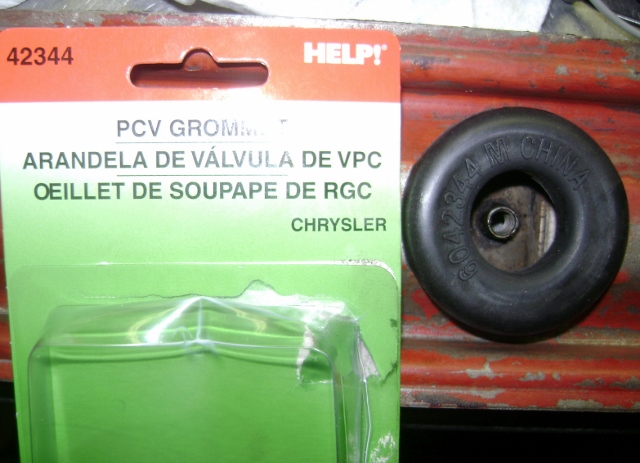
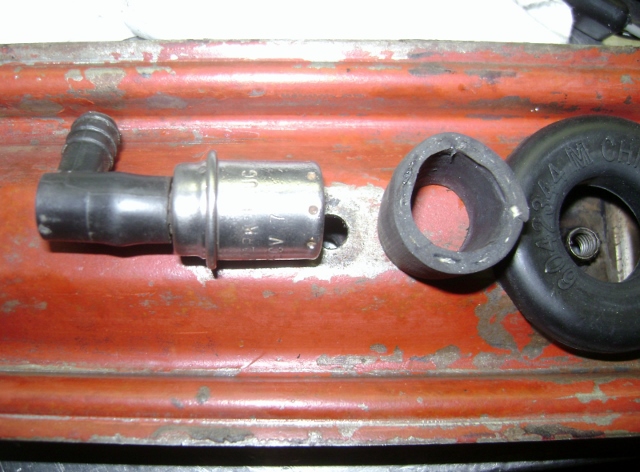
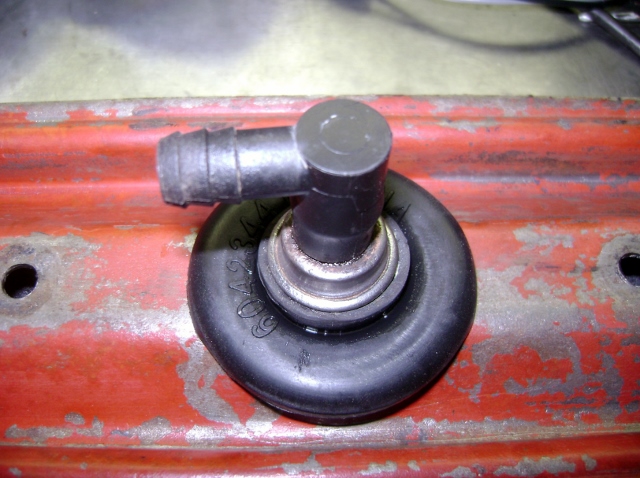
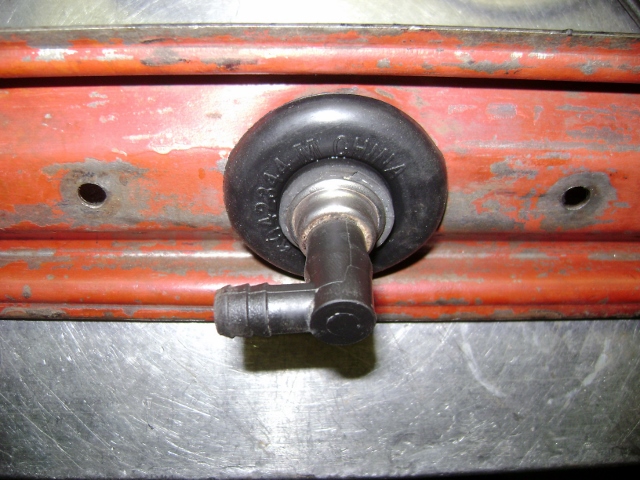
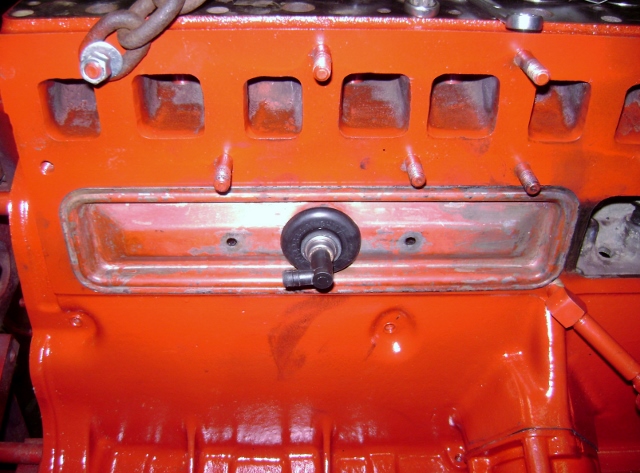
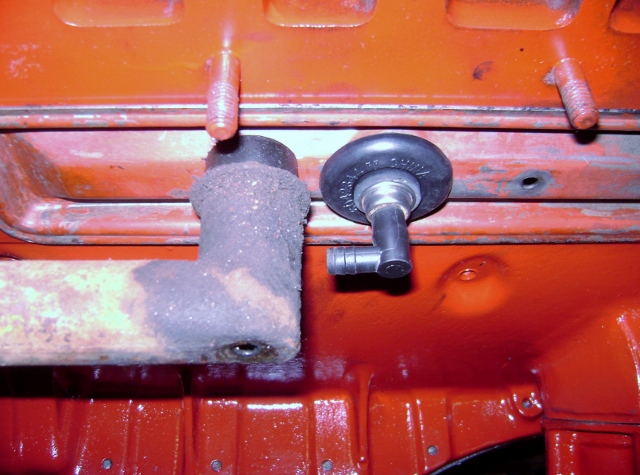 0
0 -
Although you've probably noticed, the Chrysler filler cap with the 5/8 nipple is a good match for the little K&N filter but one must effect a better seal up in the cap where the filler neck stops. I've used a 1-1/2 in. OD O-ring with a fairly stout cross section, stuffed up in there for that purpose. Other wise, dirty air would rather go that way instead of through the filter.
Pre-"Stepdown" engines were especially bad in the CC ventilation dept. since they had no provision for air inlet. A CC ventilation set-up can't scour gasses from the CC if there is no path for intake air. All of the draft tubes you could fit on the tappet chamber covers wouldn't generate flow if there's no inlet. I'm ignoring the stupid little notch on the timing gear cover since it is tiny, soon plugs with dust/oil mix and, when it is open, directs a small flow of dirty air right onto the cam gear. ? What was Hudson thinking?
F0 -
Here's what I assume is that same valve (many GM applications) plumbed into a 202 Jet. This engine is also equipped with the 202 version of the Vintage Full Flow system. I didn't mean to attach 2 photos but I don't know how to get rid of the extra one.
F0 -
In '55 and '56 engines there are two vacuum taps on the intake manifold, one for power brakes and the other an accessory. I cut the blow-by tube just after bend, welded on a plate, cut a hole for a grommet and the valve. The hose easily avoids the header and taps into the accessory vacuum tap. Works fine. I too have have an A/F monitor and the engine generally runs a little lean, but the header has a lot to do with that.
0
This discussion has been closed.
Categories
- 36.9K All Categories
- 113 Hudson 1916 - 1929
- 20 Upcoming Events
- 92 Essex Super 6
- 28.6K HUDSON
- 574 "How To" - Skills, mechanical and other wise
- 995 Street Rods
- 151 American Motors
- 179 The Flathead Forum
- 49 Manuals, etc,.
- 78 Hudson 8
- 44 FORUM - Instructions and Tips on using the forum
- 2.8K CLASSIFIEDS
- 608 Vehicles
- 2.2K Parts & Pieces
- 77 Literature & Memorabilia
- Hudson 1916 - 1929 Yahoo Groups Archived Photos




